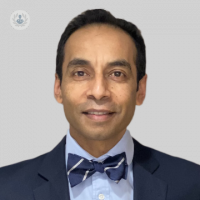Mole screening for skin cancer: what is the dermatologist looking for?
Written in association with:It is important to regularly examine your skin with a mirror, particularly in areas with moles or any skin lesions. If you develop any new moles that look different from any of your other existing ones with a change in size, colour and appearance, it is worth having a specialist make an examination for skin cancer.
Here, one of our leading London dermatologists Dr Ravi Ratnavel explains what changes to the skin that he looks for during mole screening and what you can expect during the process.

How often should people check their moles at home and in a clinic?
People with more than five moles larger than 1cm in diameter should self-examine their moles every two months, looking particularly for an increase in size and a change of colour.
Home digital photographs can prove to be very helpful. It is also useful to use a mole monitoring app, which is available for both Android and iPhones.
Clinic visits are indicated if there are more than 10 moles varying in size and appearance, an individual mole has undergone changes of diameter size or colour, or there is a past history of skin cancer, particularly with a family history.
Is it necessary to prepare for a mole screening?
Timeline photographs of any concerning moles or non-healing skin lesions brought along to the consultation can be helpful. Patients should be prepared to have their entire body examined.
What happens during a mole screening?
A clinical history relevant to skin cancer is taken before a complete body examination. Guidance is given with regards the amount of visible sun damage and education with regards to changes, which should alert future medical advice. Modern mobile phone cameras are as effective as clinic mole mapping systems.
What exactly is a dermatologist looking for during a screening for skin cancer?
The specialist is a making an assessment of photodamage and is looking for suspicious clinical signs, such as asymmetry, a variation of pigmentation, irregular borders, size and shape of moles. They are also screening for non-healing lesions suggestive of skin malignancy.
A closer examination of any unusual moles and/or lesions will be undertaken with a magnifying lens and dermatoscope. Examination of the skin may reveal unrelated skin conditions and these will be advised upon.
What happens if a mole looks suspicious/cancerous?
An initial excisional biopsy, which is the removal of the entire lesion, is recommended. The procedure is performed with the patient awake using local anaesthetic and usually leaves a small wound with skin stitches (or sutures), which will need looking after.
If you’re concerned about the appearance of one of your moles, do not hesitate to book an appointment with Dr Ratnavel today via his Top Doctor’s profile here.


